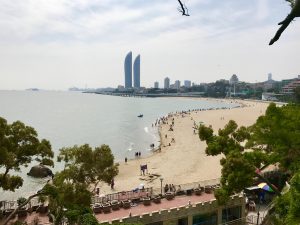When you think of China, what comes to mind? Many people would say massive cities, dense smog, and even more dense subway trains. Those things are true about certain cities, such as Beijing and Shanghai. But somehow one of China’s greatest gems, the “small” city of Xiamen (population of about 3 million), has been conveniently hidden from the world.
Located on an island along China’s subtropical southeast coast, the city of Xiamen feels a lot more like Miami than stereotypical China. The island is about seven miles in diameter and lined with beach most of the way around. Xiamen even has a French colonial heritage and still retains some European style buildings. However, despite a somewhat western feel, few outside of China are aware of Xiamen and almost no one speaks English (perfect for someone studying Mandarin, but perhaps a little inconvenient for an American tourist).
In recent years, Xiamen has become a go-to destination for wealthy Chinese looking for an island escape. The island is highly developed with towering high rise condominiums and high-end shopping malls. Still, it has an alluring, almost laid back charm. A wealthy local explained to me that throughout the 90’s, Xiamen residents were disappointed to not benefit from the wave of factories being built throughout China. But now, as China’s economy becomes more advanced, Xiamen has a comparative advantage over much of China — here, residents have the luxury of blue skies and acid-free rain.
Perhaps that is why it was selected to host the BRICS summit this Fall, featuring the heads of state from Brazil, Russia, India, China, and South Africa. The Chinese government is apparently spending $15 billion USD on various infrastructure and public works projects in preparation for this 24-hour meeting. One could say BRICS is the Chinese government’s great unveil of its hidden gem.
Xiamen has another valuable asset in Xiamen University, a top-10 Chinese university. Some of China’s brightest students call this city home and perhaps will choose to remain here after graduation. By all accounts, this costal paradise is poised for major success in the near future.
There are no direct flights from Xiamen to North America, and just one flight to outside of Asia. Unlike Shanghai and Beijing, which have been built largely by foreign investments over the past three decades, Xiamen’s development belongs entirely to China. And in September, China will reveal its masterpiece to the world.

A tower at the late-Qing Hulishan fortress.

A nice day at the beach just outside of Xiamen University’s Siming Campus.

Zhongshan Road maintains its French colonial facade with modern shopping malls hidden behind.






